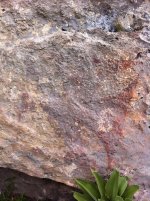I've been doing some research. I came across La Caverna del Oro. Although I've live here all my life, I've never heard of it. I found it really fascinating. There isn't a lot of information on the web. I thought it might stir some discussion.
---Located in Southern Colorado at about 12,000 feet.
---Around 1900, Elisha Horn stumbled across a skeleton clad in Spanish armor. An arrow was still sticking out of its bony back. A red cross was painted above a nearby cave entrance (the red cross can still be seen).
---It was left alone until 1920. A 105 year old Mexican woman reported that her family explored it when she was a child. She said there is gold behind oak doors.
---Among finds, are a skeleton chained by the neck, a hammer, and a rope-bucket-pulley system.
---The Spaniards probably used it as fort in the 1600's.
---The cave is huge with many passageways and rooms. It has not been completely explored or mapped.
So, were the Spanish mining the cave for gold or was it just a fort? Did they enslave Native Americans to mine gold nearby? If so, where? Why did they leave?
---Located in Southern Colorado at about 12,000 feet.
---Around 1900, Elisha Horn stumbled across a skeleton clad in Spanish armor. An arrow was still sticking out of its bony back. A red cross was painted above a nearby cave entrance (the red cross can still be seen).
---It was left alone until 1920. A 105 year old Mexican woman reported that her family explored it when she was a child. She said there is gold behind oak doors.
---Among finds, are a skeleton chained by the neck, a hammer, and a rope-bucket-pulley system.
---The Spaniards probably used it as fort in the 1600's.
---The cave is huge with many passageways and rooms. It has not been completely explored or mapped.
So, were the Spanish mining the cave for gold or was it just a fort? Did they enslave Native Americans to mine gold nearby? If so, where? Why did they leave?










